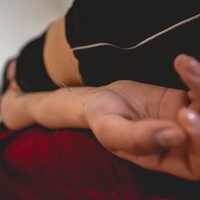
Stoptober: a fresh start for your health
From summer to autumn: letting go and finding balance
From Summer to Autumn: Moving from Earth to Metal
The Acupuncturist’s Toolbox – Pepijn Zuurdeeg on Combining Acupuncture Styles
From summer to autumn: Digestion according to the Five Elements

The acupuncturist's toolbox - customized for your complaint
Acupuncture is often seen as one fixed treatment method: needles on certain points in the body and that's it. But did you know that within acupuncture there are all kinds of different techniques and styles? A bit like a carpenter who not only has a hammer, but also a screwdriver, saw, and level. Each technique has its own strength and is tailored to what suits you and your complaint best.
Various 'tools' in practice
Below we will take you through a few of these treatment techniques that an acupuncturist can have in his or her 'toolbox', each with its own logic and application.
Ear Acupuncture - the whole body reflected in the ear
With ear acupuncture, the ear is seen as a kind of map of the whole body. Complaints elsewhere in the body can be influenced through specific points on the ear. These points are pricked with small needles or stimulated with balls or seeds, often attached with a plaster. It is used, among other things, for pain, stress, addiction, and sleep disorders.
Dr. Tan & Master Tung: mirror and balance methods with quick effect
The treatment methods of Master Tung and Dr. Tan are particularly often used for pain complaints and are known for their quick effect. Both styles make use of the mirror principle: a complaint in, for example, the knee is treated via a point on the arm or hand. However, their approaches differ slightly from each other.
Master Tung developed special points and combinations that fall outside the classic meridian and acupuncture system. His treatments are often powerful and efficient, with relatively few needles.
Dr. Tan generally used the well-known acupuncture points, but chose them based on his developed meridian balance method. This involves determining which meridians can balance each other in the body.
Both methods demonstrate how acupuncture can provide relief from pain complaints in a smart and targeted way.
Kiiko Matsumoto Style - Japanese Style with Abdominal Diagnosis
This modern Japanese style, which builds on the work of ancient Japanese masters like Master Nagano, combines traditional knowledge with practical palpation diagnosis. For example, by systematically examining the abdomen, ribs, or neck for sensitivities, the practitioner immediately tests whether a chosen point provides relief, a kind of 'live feedback.' This gentle yet profound approach is highly suitable for complex or chronic conditions, such as autoimmune diseases or hormonal imbalances.
Five Elements Acupuncture - balance between body and emotions
This style is based on the five elements from Traditional Chinese medicine: Wood, Fire, Earth, Metal, and Water. Each element is linked to specific organs, emotions, and seasons. The treatment focuses on restoring harmony between these elements, which can improve both physical and emotional complaints. This style is particularly suitable for people who feel out of balance, are burnt out, or experience recurring mood disorders.
Skull Acupuncture - for neurological and motor complaints
Skull acupuncture uses precisely defined zones on the scalp that are connected to functional brain areas. This technique focuses on influencing neurological functions such as movement, coordination, speech, and sensation. Skull acupuncture is regularly used in practice as a complementary approach to complaints related to the nervous system or movement limitations.
Traditional Chinese Acupuncture - the basis of meridians and organ systems
This is the most well-known form of acupuncture from Traditional Chinese Medicine. It involves working with the meridians (energy pathways) and the so-called Zang-Fu organs, such as liver, spleen, heart, and kidneys. The diagnostics are extensive and look at interconnections in the body. This style is widely applicable, from digestive complaints and menstrual problems to insomnia and back pain.
The Right Key for the Right Lock
Every technique has its own logic, diagnostics, and application. What works for one person may not always be the most suitable for another. That's why it's great to have a well-trained acupuncturist who masters multiple techniques. This way, the treatment can be truly tailored, whether you're suffering from migraines, burnout, or a painful shoulder.
So the next time you're at your acupuncturist and you're getting needles in your ear for a stiff neck, or in your foot for stomach pain, know this: your practitioner carefully selects from the toolbox what suits you best. Many NVA acupuncturists enjoy sharing insights into the knowledge behind this technique, so if you'd like to learn more, feel free to ask!
Curious?
In this blog, we started the conversation about the versatility of acupuncture. In the coming period, we will delve deeper into this through a series of short interviews with acupuncturists specializing in different styles. They share their vision, experiences, and show how they use their 'tools' for the best possible treatment. Keep an eye on our website and social media channels!




